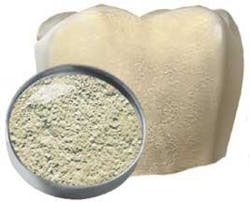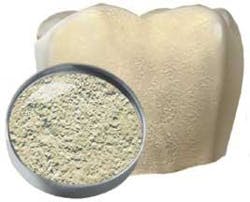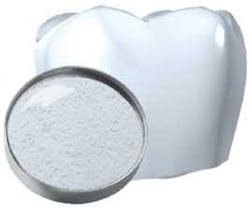Surface Enamel Wear
by Abbe Kirsten Schiffman
Editor's Note: On Jan. 29, a roundtable titled, "The evolving role of the primary care dentist" was hosted in Boston. Among other topics, the group discussed surface enamel wear. RDH invited individuals associated with the roundtable to provide the following remarks. The roundtable was supported financially by Church & Dwight Co. Inc., which manufactures Arm & Hammer dental products.
Much progress has been made in bringing caries under control. Patients are keeping their natural teeth longer and, as a result, surface enamel wear is becoming an increasing problem among patients.
Surface enamel wear can be caused by acids introduced into the oral cavity from the environment, diet, medications and general lifestyle choices. These acids break down the tooth surface structure and compromise the luster or shine of the teeth. Compensating for effects of these acids is key to healthier teeth and a brighter smile. Working closely with patients to help them understand how they can make appropriate lifestyle choices that improve the appearance of their teeth can help to prevent the need for complex and expensive restorative treatments. Working with your patients to enhance their smile is key to a lifetime of healthy teeth. This article will discuss the cosmetic and therapeutic concerns associated with surface enamel wear, as well as introduce a dentifrice that addresses the cosmetic issues.
Surface enamel and tooth wear
Surface tooth wear is a normal physiological process that occurs throughout life. Dental erosion is the loss of surface enamel produced by chemical dissolution of teeth by acids other than those produced by bacteria. If allowed to progress, what begins as solely a cosmetic problem can lead to tooth sensitivity, loss of occlusal vertical dimension, and functional problems. The initial cosmetic loss of surface enamel results in the creation of tiny crevices that causes a loss of "luster" or brightness in the tooth's appearance.
Surface enamel wear occurs in up to 80 percent of children and up to 43 percent of adults. Over time, when in the presence of carious lesions, tooth wear can become of particular concern. Younger individuals often suffer advanced tooth tissue loss before the appropriate diagnosis is made and correct treatment given. In one study, signs of erosion were found in nearly half of the 178 children between the ages of four and five. In 2002, Ayers and colleagues reported in their study of 104 5- to 8-year-old children in New Zealand that 82 percent showed some form of tooth wear in their primary molars or canines. The finding in the UK National Diet and Nutrition Survey found that up to 10 percent of children as young as one and a half years old showed signs of erosion associated with the labial surfaces in their primary incisors. The amount of erosion can have long-term consequences such as pulp exposure if this rate of erosion continues in this young population.
Dissolution of mineralized tooth structure occurs upon prolonged contact with acids that are introduced into the oral cavity from intrinsic or extrinsic acid sources. Extrinsic erosion results from the action of acids entering the mouth from an external source. Traditionally, factors that may cause extrinsic erosion have been identified as originating from the environment, diet, medications, and lifestyle choices. Environmental erosion occurs when patients are exposed to acids in their workplace or during leisure activities. More recently, there have been reports of a link between wine tasting and tooth erosion.
Acid: erosion culprit ...
Saliva: buffering hero
Ironically, healthier diets and lifestyle may be an important factor in the etiology of dental erosion. People who consume citrus fruits more than twice a day had a risk of erosion 37 times greater than that of individuals who consumed citrus fruits less often.
The quality and quantity of salivary flow may be important in the etiology of dental erosion. Saliva is important because it washes away and buffers the acid. The susceptibility of the teeth to erosion may be increased by inadequate salivary flow and buffering capacity. Before being washed away by saliva, the acids accumulate in the plaque long enough to lower the pH and cause some of the enamel mineral to dissolve, leaving tiny surface imperfections. Under normal eating conditions where between-meal snacking is limited, the enamel is remineralized through the action of the saliva. However, if food intake is frequent, the relation between demineralization and remineralization is upset and demineralization predominates.
The combination of acidic drink consumption and reduced salivary flow associated with fasting or continuous eating can increase the risk of dental erosion. Dehydrating environments can lead to the increased consumption of drinks. If these drinks are acidic, they may cause widespread occlusal erosion, which may be incorrectly attributed to attrition and bruxism. Distribution of lesions may depend on the manner that acidic substances are consumed. Drinking primarily through a straw may affect the palatal tooth surfaces; drinking from a bottle may affect the labial tooth surfaces. Habits such as swilling or holding acidic fluids in the mouth may determine the locations of the lesions. Frozen fruit juices (Popsicles or juice on a stick) may present a greater risk for tooth erosion than similar non-frozen drinks, because the frozen juices are sucked slowly and take considerably longer to neutralize.
Dieting should be considered a potentially important contributor to dental erosion. It is known that high consumption of fruits and fruit juices may be part of many individuals' weight loss plans. In addition, people with eating disorders such as anorexia nervosa and bulimia may compound their erosion with the consumption of large quantities of fruits, juices and carbonated soft drinks in addition to purging ingested food. Because of the low pH of gastric contents, the erosion has a fairly characteristic pattern of wear and tends to be more severe than that generally observed with external acidic sources.
The term intrinsic erosion implies the presence of gastric acid in the oral cavity. Vomiting, regurgitation, gastro-esophageal reflux and rumination can result in the presence of gastric acids in the oral cavity. Although not all patients with reflux disease develop erosion, regurgitation of gastric acid into the oral cavity has been associated with tooth erosion in several studies.
Caries result from the accumulation of plaque on the teeth and the production of acid (lactic acid, for example) when plaque microorganisms consume (ferment) sugars and starches in foods. Saliva modifies the potentially erosive effects of dietary foods and beverages by adjusting the pH levels. Both the quality and quantity of saliva account for observed differences in the extent of dental erosion in individuals who subject their teeth to the same level of dietary challenge.
Introduction of a toothpaste
Arm & Hammer® has used baking soda and fluoride in its oral dentifrices for decades. Baking soda is known as an effective cleaner, whitener, and stain remover, and accomplishes this with low abrasion — an important attribute when dealing with surface enamel wear. In addition, baking soda is known to neutralize odor-causing volatile sulphur compounds to deodorize oral malodors for hours. The company recently combined the attributes of baking soda with fluoride and Liquid Calcium® in a new toothpaste, Enamel Care™. Liquid Calcium is a new, patented technology that attaches to the tooth surface, combining two important minerals — soluble calcium and phosphate. Enamel Care with Liquid Calcium contains eight times the calcium and phosphate naturally found in saliva, thus providing better enamel luster restoration.
The surface enamel of the teeth is what makes teeth look smooth, glossy and lustrous. Over time, acids from everyday food and drinks leave tiny, uneven crevices in the surface enamel where unsightly plaque and stains can collect, making teeth look dull, stained and yellow.
Clinical and laboratory studies indicated that the addition of Liquid Calcium made an impressive impact on the luster of users' surface enamel. In just three months of daily use, subjects who regularly brushed twice a day with Enamel Care containing baking soda, fluoride and Liquid Calcium, saw a 23.4 percent improvement in gloss (tooth luster/shine) and a 13.7 percent reduction in tooth roughness; whereas, users of a regular fluoride toothpaste saw no significant improvement in gloss or roughness.
Patients concerned about tooth luster
In a recent survey, it was found that dental professionals are seeing the shine of their patients' teeth diminish as their surface enamel loses its luster. While more than one-third of Americans view their smile as their most important characteristic, dentists say their patients are ill informed about the best ways to care for their smiles and are not doing enough to protect those smiles.
The survey revealed that although 96 percent of dentists saw surface enamel wear in their patients' teeth, only one-third discussed the topic during routine check-ups. Most Americans are not aware of the important role surface enamel plays in the look and quality of their teeth. Subsequently, Americans are in the dark about this prevalent problem in the health and appearance of their teeth and are not aware that the lack of attention to the surface enamel of their teeth could lead to complex and expensive restorative care.
Motivation and communication with patients
Some of the most obvious solutions may be a mystery to your patients. Knowing more about your patients and their motivations can help you connect better and share your wealth of knowledge with them.
Reviewing dietary and lifestyle factors that influence oral health are important. Most patients don't realize the many factors that influence the health and luster of teeth. For example, the types of foods and beverages consumed, individual susceptibility, the frequency and time of consumption and oral hygiene practices are considered the most important factors influencing the clinical development of dental erosion.
Advice to share with your patients should include:
• Maintain a schedule of regular dental check-ups
• Brush at least twice a day
• Use a soft or medium toothbrush and a low abrasive toothpaste
• Regulate frequency of consumption of acidic foods and beverages
• Restrict acidic foods to main meals
• Finish meals with neutral foods such as cheese
• Avoid drinking acidic beverages
• Do not sip or swish acidic beverages
• Do not brush immediately following an acid challenge
• Use fluoride mouth rinses on a daily basis
• Use sugar-free chewing gum to stimulate salivary flow
Everyone wants a bright and dazzling smile. Showing your patients how to restore the luster of their teeth can make a huge difference in confidence and self-esteem. Choosing the right toothpaste and toothbrush can greatly improve oral health. For example, using toothpaste that contains baking soda, which deep cleans and buffers teeth, removes stains, and maintains fresh breath can be an enormous factor in influencing a patient's oral health.
Effective preventive programs should be administered and encouraged. There is still no better way to keep teeth healthy than oral care based on thorough clinical examination and a careful analysis of all possible etiologic factors contained in the case history of each individual.
Better and more comprehensive communications between dental professionals and patients is the key to healthier, brighter, and whiter smiles. A good communication model between dental professionals and patients to discuss oral care, lifestyle, and other factors influencing oral health could save patients time and money.
It is advisable to have patients fill out a questionnaire prior to their appointment in order to identify risk factors. A well-constructed questionnaire will help you have better communication with patients when they are in the exam room. If you see a patient only once a year, you should have the patient update the questionnaire form every year in order to see progress. Sending the questionnaire to your patient in advance of the appointment can speed up the process.
The questionnaire should be written in simple language (fifth- to eighth-grade school level) and include questions about diet (foods and beverages), medical conditions, medications being taken (prescription and over-the-counter), as well as anatomic defects and exercise regimens. Gathering patient information and discussing lifestyle choices can help the dental professional identify risk factors prior to examining the oral cavity.
Determining the cause of dental erosion is the first step to improvement. Talking to patients about lifestyle can provide the clues to their oral health. Well-aimed questions and a complete dietary record will help provide necessary information. In putting together a patient questionnaire, the following subjects should be investigated:
• Dietary habits
• Gastric disturbances (vomiting, for example)
• Medications
• Medical conditions
• Saliva production/dysfunction
• Work environment (exposure to acidic environments)
• Oral hygiene habits
• Exercise habits
• Stressful life events
• Pain
• Recent changes in health
Education is key to a healthier oral environment. It is important to speak to patients with simple terms, as this will help them understand your advice. Get a reading on your patients' oral health knowledge and take the time to talk to them about what they should do to improve oral health. Make them aware of how the food, drink and lifestyle choices they make can increase their oral health as well as overall health.
Abbe Kirsten Schiffman is an award-winning professional with more than 20 years of experience in the communications and pharmaceutical industries writing, editing, and developing Web content. She works as a consultant for Pharmaceutical Corporation of America, a member of the Publicis Healthcare Communications Group. She presently resides in East Brunswick, N.J., with her husband and two children.


